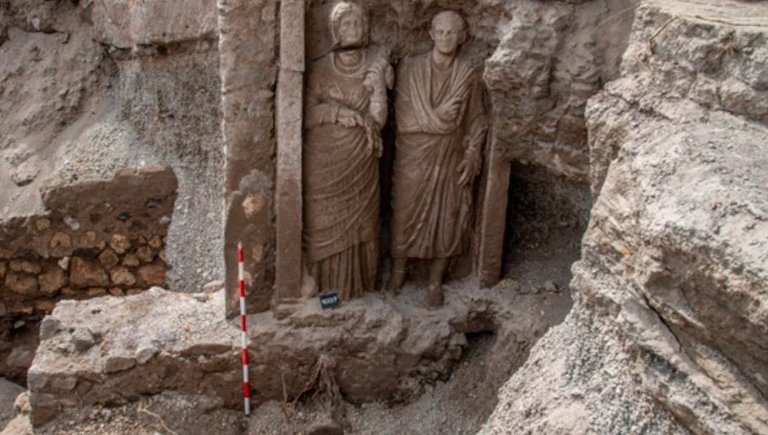Archaeologists excavating Pompeii’s Porta Sarno necropolis have uncovered a remarkable funerary relief featuring a nearly life-size depiction of a man and a woman, believed to be a couple from the city’s Late Republic period.
A Monument to the Past Emerges
The ruins of Pompeii continue to reveal astonishing glimpses into ancient Roman life. The latest discovery, a large funerary relief carved into the wall of the Porta Sarno necropolis, has left archaeologists intrigued by its artistic detail and historical significance. The sculpture, featuring a man and a woman standing side by side, dates back to the Late Republic period (200 B.C.E. – 27 B.C.E.), a time when Pompeii was a thriving trade and cultural hub.
Despite the devastation of the 79 C.E. eruption of Mount Vesuvius, along with prior earthquakes, the relief remains in remarkable condition. Traces of the couple’s clothing, accessories, and facial features are still visible, offering insight into Roman funerary art and social customs.

Excavating the Porta Sarno Necropolis
The excavation was part of the “Investigating the Archaeology of Death in Pompeii Research Project,” which has been focusing on burial sites in northeast Pompeii. The Porta Sarno necropolis, originally excavated in 1998, has been known to contain more than 50 burials, marked by funerary monuments and stelae. The newly unearthed relief is one of the most significant finds from the site.
- The relief was carved into a volcanic stone wall, a common material in Roman funerary architecture.
- Beneath the sculpture, archaeologists identified several niches indicating the presence of a larger underground tomb.
- The tomb is believed to have suffered significant damage from pre-eruption earthquakes, leading to its partial collapse.
The discovery adds to the growing body of evidence about how Romans honored the deceased and structured their burial sites.
Insights into Roman Life and Death
This relief, depicting what is presumed to be a married couple, provides further evidence of the social and religious customs of Pompeii’s residents. The placement of the figures, their attire, and the craftsmanship of the relief suggest that the individuals were of notable status within the community.
Dr. Gabriel Zuchtriegel, director of the Pompeii Archaeological Park, emphasized the importance of such findings. “Each new discovery brings us closer to understanding the daily lives, beliefs, and social structures of Pompeii before its tragic destruction.”
The Preservation and Future Study of the Relief
Archaeologists are now working on stabilizing the relief to prevent further degradation. Researchers hope to analyze the pigments and tool marks left on the stone to gain deeper insight into Roman sculptural techniques and burial practices.
With ongoing excavations in and around Pompeii, the necropolis at Porta Sarno remains a promising site for uncovering more secrets buried beneath centuries of volcanic ash. This latest find reaffirms that even after centuries of study, Pompeii still has stories to tell.













